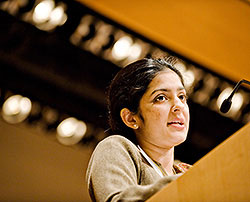As part of the overarching study presented on April 30th about the post 9/11 experiences of Muslim public school students in New York City, TC doctoral student Ameena Ghaffar-Kucher talked about her own case study of the academic engagement and socialization of Muslim Pakistani immigrant youth.
As part of the overarching study presented on April 30th about the post 9/11 experiences of Muslim public school students in New York City, TC doctoral student Ameena Ghaffar-Kucher talked about her own case study of the academic engagement and socialization of Muslim Pakistani immigrant youth. Ghaffar-Kucher’s presentation was followed by responses by Moustafa Bayoumi, associate professor of English at Brooklyn College, City University of New York (CUNY); and Zareena Grewal, assistant professor in the departments of American Studies and Religious Studies at Yale.
Ghaffar-Kucher, who spent three years studying Pakistani immigrant high school students in New York for her dissertation research, began by noting that while Pakistanis form the largest immigrant group in the United States and they are nearly all Muslim, they vary greatly in the degree to which they are religious, politically active, and culturally engaged in the United States. Pakistani youth, especially, create a complex web of identities for family, school, religious, and cultural settings that cut across race, gender, language, national, ethnic, and religious ties. Since 9/11, they have been doing so as Muslims have been viewed as an “alienated and problematic” minority, Ghaffar-Kucher said.
Outsiders see Pakistanis as Muslims and nothing more, so that, particularly for young Pakistanis, religion becomes a marker of both identity and difference, Ghaffar-Kucher said. Pakistani youth identify with Islam not so much out of religiosity, but as an act of politics. “The experience of being ostracized actually strengthened their Muslim identity,” even if they did not become more religious, she added.
After 9/11, Pakistani youth felt they no longer could be considered American, since in their perception, Americans didn't like Muslims. Many reported claiming a Muslim identity but not as a sign of increased religiosity, rather as a way to find a community to which they felt they belonged.
Some Pakistani youth, mostly boys, act out their anger by joking and making fake threats, for example, to “blow up” someone’s house. At the same time, the students described many open and subtle aggressions against them by their non-Muslim peers and teachers. For example, she said, some high school guidance counselors assumed that the daughters of conservative Pakistani immigrants would never go to college, and so steered them toward careers that wouldn’t require it.
In general, Ghaffar-Kucher found that, for many Pakistani youth, ethnic, nationalist and religious ties often win over the pull that any immigrant feels toward American “modernity.” In response, they assert a form of cultural nationalism and obvious Muslim identity that perpetuates their sense of separateness. “Pakistani youth see themselves as outside the mainstream of American culture,” she concluded.
Bayoumi affirmed that he, too, had made many of the same observations about Pakistani and Muslim youth in studying an older cohort of Muslim immigrants, ages 19 to 29, in Brooklyn. Unlike Ghaffar-Kucher, however, he reported finding an increased interest and practice of Islam, and increased religious conservatism and proselytizing, among slightly older Muslim immigrants.
Grewal also praised Ghaffar-Kucher’s study as important to understanding Muslims in contemporary America, but said she would argue for a more flexible and contextual definition of Islamic religious practice and culture.
Published Friday, May. 2, 2008
